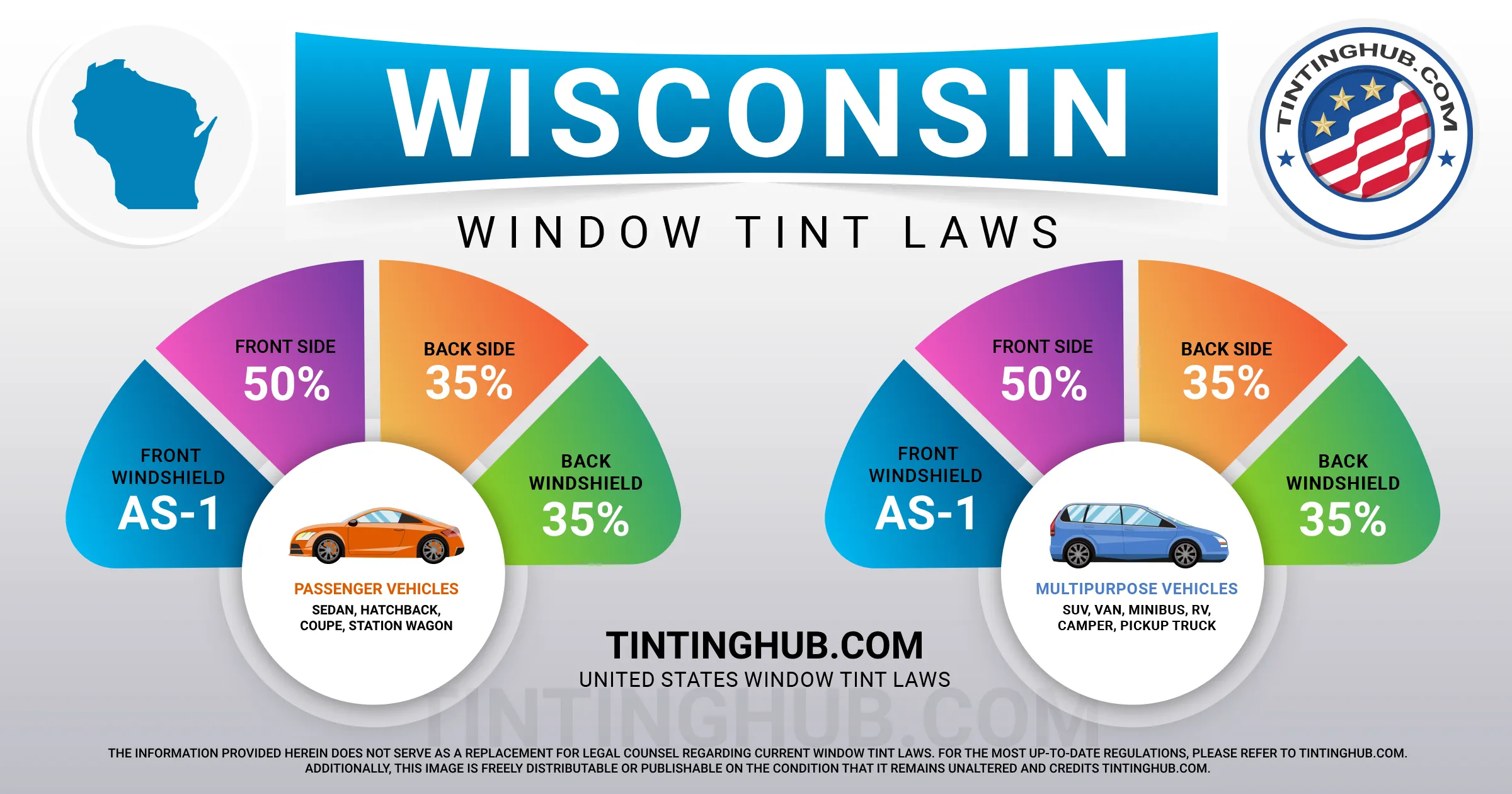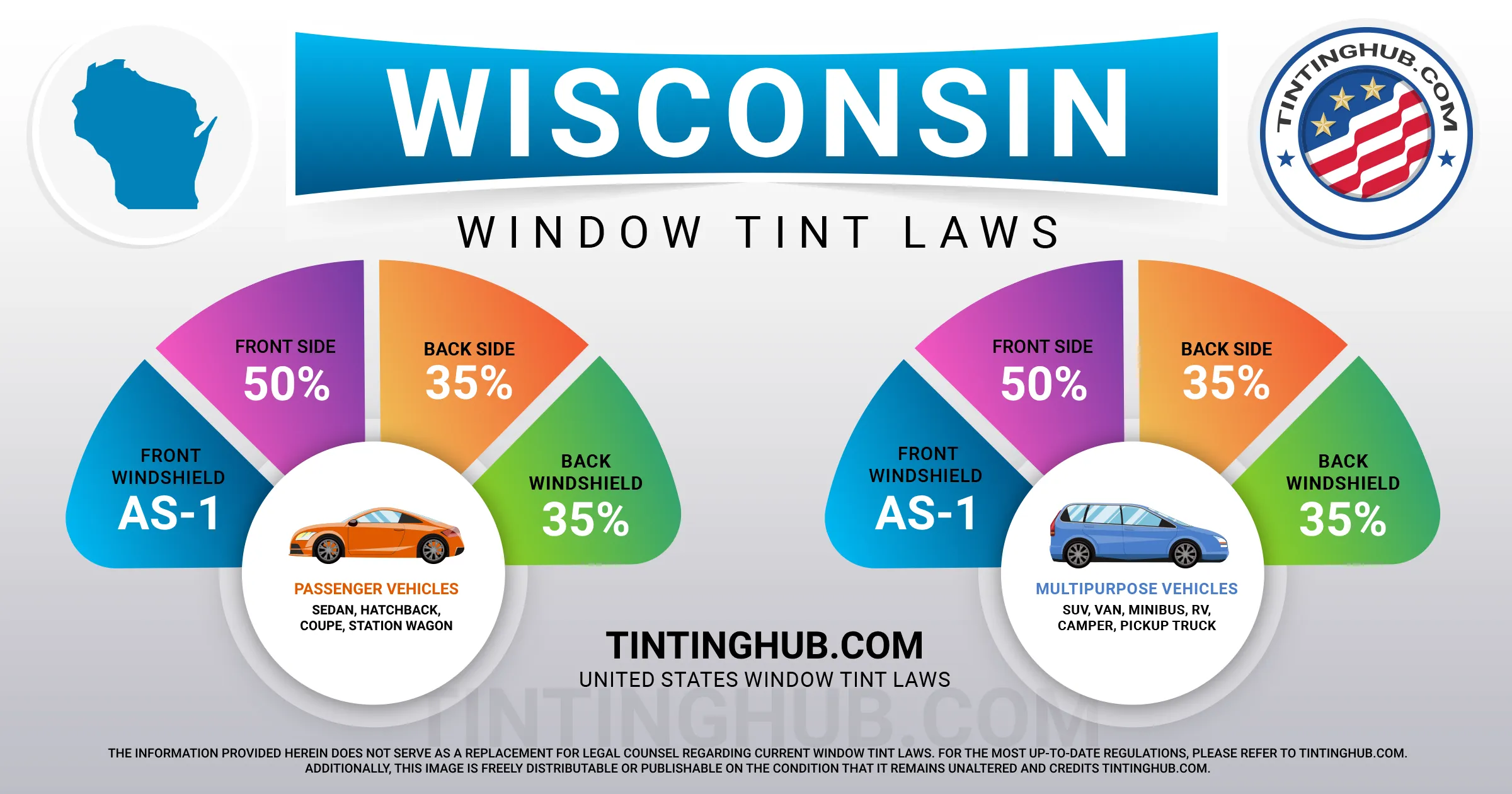Wisconsin Window Tint Laws (Last Update 2024)

When it comes to enhancing the aesthetics and comfort of your vehicle, window tinting can be a game-changer. However, to ensure you stay on the right side of the law in Wisconsin, it’s crucial to understand the state’s window tinting regulations. In this comprehensive guide, we’ll explore the specifics of Wisconsin’s window tint laws, shedding light on VLT (Visible Light Transmission), darkness limits, reflection rules, and other essential details.

Understanding VLT – Your Window to Compliance
VLT, or Visible Light Transmission, is the key to comprehending Wisconsin’s window tinting laws. To avoid legal complications, it’s vital to know how much light is allowed to pass through your car windows. The permissible VLT percentages differ between sedan cars and SUVs or vans.
Sedan Car Tint Darkness Requirements
For sedans, the regulations are as follows:
- Windshield: Non-reflective tint is allowed above the manufacturer’s AS-1 line.
- Front Side Windows: Must allow more than 50% of light to pass through.
- Back Side Windows: Must permit more than 35% of light to enter.
- Rear Window: Must allow more than 35% of light in.
SUV and Van Tint Darkness Guidelines
If you drive an SUV or a van, these are the tint darkness rules:
- Windshield: Non-reflective tint is allowed above the manufacturer’s AS-1 line.
- Front Side Windows: Must permit more than 50% of light to pass through.
- Back Side Windows: Must allow more than 35% of light in.
- Rear Window: Must allow more than 35% of light in.
Reflecting on Tint – Keeping Glare at Bay
Window tint can do more than just make your vehicle look cool; it can also reduce glare and heat. However, it’s crucial to ensure that your tint complies with Wisconsin’s regulations regarding tint reflection.
Tint Reflection for Sedans
For sedans, the guidelines are clear:
- Front Side Windows: Tinting film must not be reflective.
- Back Side Windows: Tinting film must not be reflective.
Tint Reflection for SUVs and Vans
SUV and van owners should follow the same rules:
- Front Side Windows: Tinting film must not be reflective.
- Back Side Windows: Tinting film must not be reflective.
Beyond the Basics – Additional Regulations
Wisconsin’s window tint laws encompass more than just VLT and reflection. Here are some other important regulations to be aware of:
- Side Mirrors: If your rear window’s VLT is below 60%, you must have dual side mirrors.
- Tint Colors: Wisconsin does not restrict tint colors, giving you some creative freedom.
- Tint Variance: A 3% variance is allowed, ensuring a bit of flexibility in adhering to the VLT limits.
- Certificates: Unlike some states, film manufacturers do not need to certify the film they sell in Wisconsin.
- Stickers: Wisconsin does not require stickers to identify legal tinting.
- Medical Exceptions: If you have a valid medical reason, you may be eligible for darker tint. Consult local authorities for more information.
Keep Your Local Context in Mind
It’s important to note that Wisconsin’s tinting laws and regulations may be subject to interpretation at the county or local level. To ensure complete compliance, we recommend double-checking the information with your local DMV or law enforcement authorities.
Our commitment to providing accurate information about window tint laws in Wisconsin is unwavering. This guide was last updated in 2023. If you come across any outdated or incorrect information, please don’t hesitate to contact us so we can make the necessary updates. Your trust in our accurate, up-to-date information is our priority.
When it comes to window tinting, knowing the rules is the first step toward enhancing your vehicle while staying on the right side of the law. Trust the industry leader in providing accurate window tint laws for all your tinting needs.